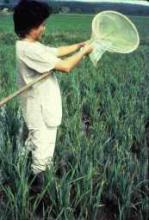Labour-saving technologies and practices: integrated pest management
The following practice describes the features of integrated pest management, listing various agricultural practices to prevent development and spread of pest populations. The advantages and disadvantages are also detailed in terms of livelihood resilience strengthening, livelihood diversification, skills, cost, risk labour and infrastructure.
Description
Pesticide application using a knapsack sprayer can be expensive and present negative health and safety and environmental impacts due to limited training, inappropriate use and storage and lack of protective clothing.
1. Features of integrated pest management
1.1 Aim
- The aim of integrated pest management is to develop an understanding of the ecology and life cycles of the main pest species and their predators, also known as “beneficial”.
- This identifies the periods when interventions would be effective in controlling pests and in introducing or attracting predators of the pests.
1.2 Integrated pest management and agricultural practices
Various agricultural practices should be used.
- Crop rotations to break up the life cycle of pests and prevent their population growth
- Inter-row cropping with crop species which either repel pests or attract predators of the pest species. For example, napier grass (Pennisetum purpureum) planted round the edge of a maize plot attracts stem borer moths away from maize while molasses grass (Melinis minutiflora), inter‑cropped between the maize, discourages the maize borer and attracts a parasitic wasp that prey on stem borers.
- Accurate monitoring of pest levels to determine when intervention is necessary.
- Setting pest traps and physically removing and destroying pests.
- Minimum use of pesticides to control pests. This is done as a last resort and only narrow spectrum insecticides are used.
2. Advantages
2.1 Livelihood resilience strengthening
- Integrated pest management increases yields and reduces labour input per kilogram of production.
- Long-term sustainability of the ecosystem is also improved.
- Crops will be more resistant in the long run against pests and diseases, securing the production for the farmer.
2.2 Livelihood diversification
- Using this practice gives an opportunity to be eligible to sell organic produce at higher value than standard produce.
2.3 Skills
- It is advisable to try this kind of management out on a small scale at first.
2.4 Cost
- The practice reduces expenditure due to reduced pesticide inputs.
2.5 Risk
- There is very little risk involved.
Figure 1. Pest collection

©FAO/TECA
3. Disadvantages
3.1 Labour
- Significant inputs of time are required to develop skills, monitor crops and set traps.
3.2 Skills
- Extensive training and an understanding of the ecosystem are required.
3.3 Infrastructure
- A specialist trainer is required in integrated pest management.
4. Related/associated technologies
- Wheat cultivation with levelling and integrated pest management: ID 10015.
- Integrated Pest Management (IPM) in vegetable production: a guide for extension workers in West Africa: ID 6963.
- Integrated Pest Management (IPM) in the quality control for the production of extra virgin olive oil: ID 8607.
5. Objectives fulfilled by the project
5.1 Labour saving technology
The technology aims at reducing the amount of labour required per kilogram of production through the practices of the integrated pest management.
5.2 Resource use efficiency
The practice improves ecosystem sustainability and crop resistance to pests and diseases.
5.3 Pro-poor technology
The practice increases yields and provides opportunity to sell produce at a higher value. It also reduces pesticide expenditure.
